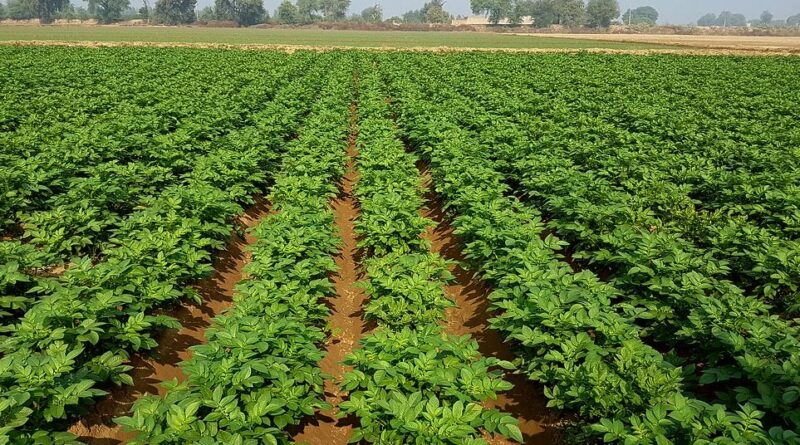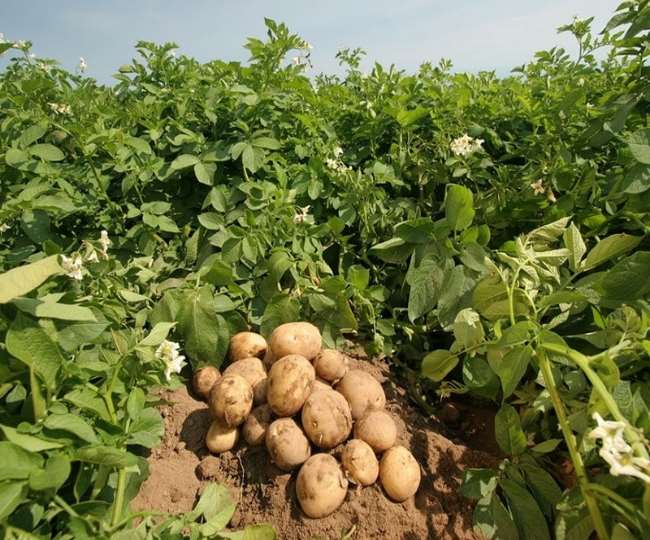प्याज की खेती एक महत्वपूर्ण कृषि प्रक� ...
Potatoes are a versatile and widely consumed root vegetable, rich in nutrients such as carbohydrates, vitamins, and minerals. They are cultivated globally and thrive in cool climates with well-drained, fertile soil. Potatoes are used in various culinary dishes and play a crucial role in food security. Farming practices, including proper soil preparation, irrigation, pest management, and timely harvesting, are essential for maximizing potato yields and quality.
आलू एक महत्वपूर्ण खाद्य फसल है, जिसे दुनिया भर में बड़े पैमाने पर उगाया और खाया जाता है। इसमें कार्बोहाइड्रेट, विटामिन C और पोटैशियम प्रचुर मात्रा में होते हैं, जो ऊर्जा और पोषण प्रदान करते हैं। आलू की खेती के लिए उपजाऊ, अच्छी जल निकासी वाली मिट्टी और ठंडे मौसम की आवश्यकता होती है। यह फसल लगभग 90-120 दिनों में तैयार हो जाती है और इसका उपयोग सब्जी, चिप्स, फ्रेंच फ्राइज जैसे विभिन्न रूपों में किया जाता है।
आलू एक महत्वपूर्ण और व्यापक रूप से उगाई जाने वाली फसल है, जिसका उपयोग दुनिया भर में मुख्य खाद्य पदार्थ के रूप में किया जाता है। यह विटामिन सी, पोटैशियम और फाइबर से भरपूर होता है। आलू की खेती सही तकनीकों और प्रबंधन से अत्यधिक लाभकारी हो सकती है। इस लेख में हम आलू की खेती के विभिन्न पहलुओं जैसे मिट्टी की तैयारी, बुवाई, सिंचाई, खाद प्रबंधन और कटाई पर चर्चा करेंगे।

आलू की खेती के लिए कई किस्में उपलब्ध हैं, जिन्हें किसान अपनी जलवायु और मिट्टी के अनुसार चुन सकते हैं। कुछ प्रमुख किस्में हैं:
1. कुफरी ज्योति
2. कुफरी अशोक
3. कुफरी पुखराज
4. कुफरी सिंदूरी
हर किस्म का उत्पादन और रोग प्रतिरोधक क्षमता अलग-अलग होती है, इसलिए सही किस्म का चुनाव आवश्यक है।
आलू की खेती के लिए उपजाऊ, दोमट मिट्टी सबसे उपयुक्त मानी जाती है। मिट्टी का पीएच स्तर 5.2 से 6.4 के बीच होना चाहिए। ठंडी जलवायु में आलू की पैदावार अच्छी होती है, जबकि अत्यधिक गर्मी फसल के लिए हानिकारक हो सकती है। बुवाई के समय तापमान 18-20 डिग्री सेल्सियस और कंदों के विकास के समय 15-18 डिग्री सेल्सियस होना चाहिए।
आलू की अच्छी पैदावार के लिए खेत की सही तैयारी बहुत महत्वपूर्ण है। सबसे पहले खेत को 2-3 बार अच्छी तरह से जोतें, जिससे मिट्टी भुरभुरी और ढीली हो जाए। इसके बाद गोबर की खाद या जैविक खाद 20-25 टन प्रति हेक्टेयर की दर से मिलाएं, जिससे मिट्टी की उर्वरकता बढ़ सके।
)
आलू की बुवाई का सही समय क्षेत्र के अनुसार भिन्न होता है। सामान्यतः, उत्तर भारत में अक्टूबर-नवंबर में और दक्षिण भारत में सितंबर-अक्टूबर में बुवाई की जाती है। आलू की बुवाई के लिए 5-6 सेंटीमीटर गहरे गड्ढों में बीजों को लगाना चाहिए और हर पौधे के बीच 20-25 सेंटीमीटर की दूरी रखें। पंक्तियों के बीच की दूरी 60 सेंटीमीटर होनी चाहिए।
आलू की फसल में पर्याप्त नमी की जरूरत होती है, खासकर कंदों के विकास के समय। पहली सिंचाई बुवाई के तुरंत बाद करें। इसके बाद, हर 7-10 दिनों के अंतराल पर सिंचाई करें। ध्यान रहे कि फसल के आखिरी 15-20 दिनों में सिंचाई न करें, ताकि कंद सूख सकें और उनका आकार बढ़ सके।
आलू की फसल के लिए संतुलित खाद और उर्वरकों का उपयोग बहुत जरूरी है। सामान्यतः, नाइट्रोजन, फॉस्फोरस और पोटाश का अनुपात 120:60:100 किलोग्राम प्रति हेक्टेयर होना चाहिए। नाइट्रोजन का आधा हिस्सा बुवाई के समय और बाकी फसल की वृद्धि के दौरान डालें। जैविक खाद का भी उपयोग किया जा सकता है, जिससे मिट्टी की गुणवत्ता में सुधार होता है।
आलू की फसल को प्रभावित करने वाले मुख्य रोगों में पत्तियों का धब्बा, आलू का झुलसा और कंद सड़न शामिल हैं। कीटों में आलू के कीड़े और मक्खियां सबसे सामान्य हैं। इनसे बचाव के लिए जैविक और रासायनिक उपाय अपनाए जा सकते हैं। समय-समय पर फसल की निगरानी करना और उचित दवाओं का उपयोग करना महत्वपूर्ण है।

आलू की फसल बुवाई के 90-120 दिनों के भीतर तैयार हो जाती है। जब पौधों की पत्तियां सूखने लगें, तब आलू की कटाई करें। कटाई के बाद, आलुओं को अच्छी तरह से धूप में सुखाएं और फिर ठंडी और हवादार जगह पर भंडारण करें। इससे आलू लंबे समय तक सुरक्षित रहते हैं।
यह भी पढ़ें: गाजर की खेती | पत्तागोभी की खेती
आलू की खेती सही तकनीकों और प्रबंधन के साथ बेहद लाभदायक हो सकती है। उचित मिट्टी की तैयारी, समय पर बुवाई, सिंचाई और खाद प्रबंधन से किसान अच्छी पैदावार और मुनाफा कमा सकते हैं। फसल की देखभाल और कीट-रोग नियंत्रण पर ध्यान देना फसल की गुणवत्ता और मात्रा को सुनिश्चित करता है।
Potatoes are one of the most widely cultivated and consumed crops in the world. With their versatility and nutritional value, potatoes play a crucial role in global food security. To maximize yields and quality, potato farming requires careful attention to soil, climate, irrigation, pest control, and harvesting techniques. This guide provides detailed insights into successful potato farming practices.
There are many varieties of potatoes, each suited to different climates, soil types, and purposes. Popular varieties include:
1. **Kufri Jyoti**
2. **Kufri Bahar**
3. **Kennebec**
4. **Russet Burbank**
5. **Desiree**
Choosing the right variety depends on factors like local growing conditions and market demand.
Potatoes thrive best in well-drained sandy loam or clay loam soils with a pH between 5.0 and 7.0. The soil should be rich in organic matter and have good moisture retention capacity. Potatoes grow well in cool climates with temperatures between 15°C to 25°C. Excessive heat can damage tuber formation, while frost can harm the crop.
Proper land preparation is essential for healthy potato crops. The soil should be plowed deeply and left to weather for a few days to break clods. Well-decomposed organic manure or compost (15-20 tons per hectare) can be added to enhance soil fertility. Forming raised beds or ridges will help improve drainage and aeration, preventing waterlogging during heavy rains.
Potato planting time varies depending on the region and climate. In temperate regions, potatoes are typically planted in early spring, while in tropical and subtropical areas, they are planted during the cooler months. The seed tubers (small potatoes) should be planted 10-15 cm deep, with a spacing of 20-30 cm between plants and 60-75 cm between rows.
Potatoes need consistent moisture for proper tuber development. Irrigate immediately after planting and maintain regular irrigation throughout the growing season. Critical stages for irrigation are at tuber initiation and during the bulking stage. Ensure that the soil remains moist but not waterlogged, as excess water can lead to diseases like rot.
Potatoes are heavy feeders and require a balanced nutrient supply. Apply nitrogen (N), phosphorus (P), and potassium (K) in the recommended ratio. A general guideline is 100-120 kg of nitrogen, 60-80 kg of phosphorus, and 100-120 kg of potassium per hectare. Split nitrogen applications can be made, with half applied during planting and the rest at tuber initiation.
Weeds compete with potatoes for nutrients, water, and sunlight. Regular weeding and hoeing are essential to prevent competition and encourage healthy growth. Mulching can also help suppress weed growth and conserve soil moisture.
Common pests that attack potato crops include aphids, potato beetles, and cutworms. Diseases such as late blight, early blight, and black scurf can also affect yields. To manage these issues, adopt integrated pest management (IPM) practices, including crop rotation, resistant varieties, and the use of biopesticides or chemical treatments when necessary.
Potatoes are typically ready for harvest 90-120 days after planting, depending on the variety. Harvest when the foliage has turned yellow and starts to die back. Carefully dig up the tubers to avoid damaging them. After harvesting, cure the potatoes by drying them in a cool, dark place for about two weeks. Proper curing extends shelf life by hardening the skin and healing small wounds.
Potato farming is a rewarding agricultural activity that can provide high yields with the right practices. By selecting suitable varieties, ensuring proper land preparation, irrigation, and nutrient management, and controlling pests and diseases, farmers can maximize their potato crop’s quality and profitability. With increasing global demand, potato farming offers a viable option for both small-scale and commercial farmers.
0
0
प्याज की खेती एक महत्वपूर्ण कृषि प्रक� ...
Garlic is a widely used spice and medicinal plant cultivated for centuries. It is known for its spic ...
Coriander farming offers lucrative returns for farmers due to its high demand in the culinary and me ...
September is an ideal month for sowing various vegetables that can be harvested in the cooler months ...
Ghiya, also known as bottle gourd, is a popular and nutritious vegetable grown in many parts of Indi ...
Tomato farming is a popular agricultural practice due to the high demand for tomatoes worldwide. It ...
खीरा की खेती एक लाभदायक कृषि व्यवसाय ह ...
अक्टूबर का महीना शरद ऋतु का प्रारंभ हो ...
Beetroot cultivation is a profitable agricultural venture that involves growing a nutritious root ve ...
Tauri, also known as Ridge Gourd, is a popular vegetable cultivated in many parts of Asia. It is hig ...
Eggplant, also known as Brinjal or Solanum melongena, is a widely cultivated vegetable in India, pri ...
Pea (Pisum sativum) is one of the major legume crops in India, used both as a vegetable and a pulse. ...
Chickpea (Cicer arietinum) is an important pulse crop, particularly grown in India. Its cultivation ...
Sem, also known as ‘Beans,’ is a significant leguminous crop that is not only rich in nutrition ...
Bathua (Chenopodium album) is a nutritious leafy vegetable commonly grown during the winter season i ...
Lentils (Lens culinaris) are a valuable pulse crop grown in India during the Rabi season. Known for ...
The winter season is an excellent time for farmers, especially for cultivating vegetables. Vegetable ...
After harvesting rice, it is important for farmers to plan for the next crop. This is the time when ...
December marks the beginning of winter, making it an ideal time for vegetable farming. This season p ...
Red spinach, known as "लाल साग" in Hindi, is a nutrient-rich leafy vegetable that stands ...
There’s something special about enjoying freshly grown vegetables from your own home. It’s not o ...
February is an important time for agriculture, especially for farmers who are preparing for rabi and ...
Fruit drop or lack of fruiting in bottle gourd plants is a common issue, whether they are grown in s ...